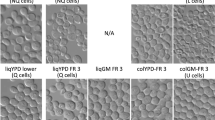Summary
Much of the confusion in the interpretation of the cytological pictures observed in yeasts could be traced to the wrong assumption that cells from cultures under entirely different physiological conditions should exhibit uniform cytological behaviour.
The only rational method of approach will be to investigate the nuclear behaviour under each specific cultural condition. A critical evaluation of some recent publications is presented.
Photomicrographs showing the cytological pictures during the aerobic and anaerobic phases are presented to illustrate the confusion that would result if attention is confined to either of the above cultural methods, for evaluation.
The cytological pictures observed in cells taken from a 24-hour agar slant are entirely different from that observed in actively proliferating cells in well aerated media. Photomicrographs and camera lucida drawings are presented as evidence that the varying number of bodies seen represent an ascending grade of endopolyploidy.
It is emphasized that the behaviour of the yeast nucleus under aerobic proliferation alone should be taken as the standard for the evaluation of the changes under different cultural conditions.
Endopolyploidy appears to be a specific modification to meet particular conditions of existence.
Similar content being viewed by others
References
Badian, J. “Sur la Cytologie des Levures,”Bull. Internat. Acad. Polonaise. Sci. et Lettr. Cl. Sci. Ser. B. Sc. Nat., 1937,1, 61–87.
Geitler, L. “Die analyse des Kernbaus und den Kernteilung der WasserlauferGerris lateralis undGerris lacustris (Hemiptera, Heteroptera) und die Somadifferenzierung,”Zeit. Zellf. mikr. anat., 1937,26, 641–72.
Guilliermond, A.The Yeasts, 1920, John Wiley & Sons., New York.
Lindegren, C. C. “An Analysis of the Mechanism of Budding in Yeasts,”Mycologia, 1945,37, 767–80.
— and Rafalko, M. M. “The Structure of the Nucleus ofSaccharomyces Bayanus,”Exptl. Cell. Research, 1950,1, 169–87.
Levan, A. “Studies on the Camphor Reaction of Yeasts,”Hereditas, 1947,33, 457–514.
Lorz, A. P. “Supernumerary Chromosomal Reproductions; Polytene chromosomes, Endomitosis, Multiple Chromosome Complexes, Polysomaty,”Bot. Rev., 1947,13, 597–624.
Menzinsky, G. “On factors influencing the metabolism and growth ofS. cerevisiæ (Top yeast) under aerobic conditions,”Arkiv. f. Kemi., 1950,2, 1–94.
Mitra, K. K. and Subramaniam, M. K. “Some Observations on the Effect of Chrysene on Yeasts,”Cellule, 1949,53, 7–12.
Nagel, L. “A Cytological Study of Yeast (Saccharomyces cerevisiæ),”Ann. Mo. Bot. Gdn., 1946,33, 249–88.
Rafalko, J. S. “A Modified Technique for Small and Diffuse Chromatin Elements,”Stain. Tech., 1946,21, 91–94.
Ranganathan, B. and Subramaniam, M. K. “Studies on the Cytology of Yeasts. V. Normal and Abnormal Mitoses in a Distillery Yeast,”Proc. Nat. Inst. Sci., India, 1948,14, 389–405.
Sharp, L. W.Introduction to Cytology. 1934. III Edn. McGraw Hill Co., New York.
Sinoto, Y. and Yuasa, A. “Karyological Studies inSaccharomyces cerevisiæ,”Cytologia, 1941,11, 464–72.
Subramaniam, M. K. and Ranganathan, B. “Staining the Chromosomes of Yeasts by the Feulgen Technique,”Nature, 1946,157, 657–58.
Subramaniam, M. K. “Is the Macronucleus of Ciliates Endopolyploid,”Curr. Sci., 1947,16, 228–29.
— “Studies on the Cytology of Yeasts. III. The Technique of Handling Yeasts for Cytological Investigations,”Proc. Nat. Inst. Sci., India, 1948a,14, 315–23.
— “Studies on the Cytology of Yeasts. IV. Endopolyploidy in Yeasts,” —, 1948b,14, 325–33.
— “On the Identification of the Various Cell Structures in Yeast,”J. Ind. Inst. Sci., 1952,34 A, 11–23.
White, M. J. D.Animal Cytology and Evolution, Camb. Univ. Press., 1945.
Wings, O. “On Hapiophase and Diplophase in some Saccharomycetes,”C. R. Lab. Carlsberg, Ser. Physiol., 1935,21, 77–112.
— and Roberts, C. “Inheritance of Enzymatic Characters in Yeast and the Phenomenon of Long-Term Adaptation,” —, 1948,24, 263–315.
— “The Polymeric Genes for Maltose Fermentation in Yeasts and Their Mutability,” —, 1950,25, 36–80.
— “The Relation between Yeast Cytology and Genetics. A Critique,” —, 1951,25, 85–99.
Author information
Authors and Affiliations
Rights and permissions
About this article
Cite this article
Prahlada Rao, L.S., Subramaniam, M.K. Studies on the cytology of yeasts. Proc. Indian Acad. Sci. 37, 72–81 (1953). https://doi.org/10.1007/BF03050190
Received:
Issue Date:
DOI: https://doi.org/10.1007/BF03050190




